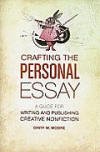Crafting the Personal Essay
Perhaps the highest praise I can offer Moore’s instructional book on writing the personal essay is this: when I started reading it, I had no intention or desire to write an essay, and now, having finished it, I already have a list of potential projects I’m ready to begin. His easygoing, conversational style and encouraging tone (“Everyone has bad days. So don’t beat yourself up about it”) make the book an easy read, and most of his advice is concrete and specific.
Perhaps the highest praise I can offer Moore’s instructional book on writing the personal essay is this: when I started reading it, I had no intention or desire to write an essay, and now, having finished it, I already have a list of potential projects I’m ready to begin. His easygoing, conversational style and encouraging tone (“Everyone has bad days. So don’t beat yourself up about it”) make the book an easy read, and most of his advice is concrete and specific.
Moore begins with an overview of just what defines the personal essay: “A successful essay,” he writes, “is a hunt, a chase, a ramble through thickets of thought, in pursuit of some brief glimmer of fuzzy truth.” The chapters that follow examine specific types of essays: memoir essays, lyric essays, nature essays, spiritual essays, travel essays, and so forth. He offers both writing exercises and topic ideas in each section. He also analyzes successful essays by Agnes Repplier, Michel de Montaigne, Virginia Woolf, and himself.
Throughout the entire book, he illustrates his own suggestions through his own essay in progress, the finished version of which is included in one of the appendices.
Most of the suggested writing exercises are helpful, though some may seem familiar to those of us who have read a few (or few hundred) writing manuals. One exercise offers up the topic, “Why Do I Write?”, a subject I’ve encountered more than once in manuals and workshops, as is the directive to write about a childhood memory. Part Two of the book, which covers writing habits, revision, and publication, includes information found in pretty much every writing book out there: establish a regular writing routine, know your market, don’t get discouraged by rejection slips, and so on. It’s good advice, but if you’ve been writing for any length of time, you’ve heard it before.
Show, don’t tell: that’s another piece of advice you’ll hear over and over again, and Moore’s book proves it. The portions of the book where he uses examples of well-written essays to illustrate his points are by far the most helpful, and the most interesting. He uses three essays of his own, which allows him to explain his thought processes throughout the writing (something he obviously can’t do with Woolf or Montaigne). My only nitpick on this point: I wish he had used a humorous essay from Robert Benchley, Dave Barry, or David Sedaris, because while his own was mildly amusing, it was not what you’d call a knee-slapper.
I think my favorite chapter is “Write What You Wish You Knew,” in which Moore recommends using your essay writing to investigate subjects of curiosity. He references one writer who went back to his childhood summer camp as an adult camper, and A.J. Jacobs’s book The Year of Living Biblically: One Man’s Humble Quest to Follow the Bible as Literally as Possible. He also provides a fun list of seven-day experiments to spark the reader’s imagination (a week watching nothing but the Food Network, for example).
As Moore describes it, writing the essay sounds like a lot more fun than the perennial start-of-school slog through “What I Did Over Summer Vacation.” I highly recommend taking his advice for a “ramble through thickets of thought.” Who knows where you’ll end up?





